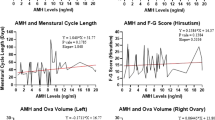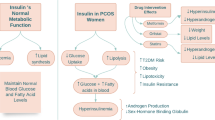Abstract
Purpose
The recently identified agonistic autoantibodies (AAb) to the gonadotropin-releasing hormone receptor (GnRHR) are a novel investigative and therapeutic target for polycystic ovary syndrome (PCOS). In this study, we used a new cell-based fluorescence resonance energy transfer (FRET) bioassay to analyze serum GnRHR-AAb activity and examine its relationship with testosterone and proinflammatory cytokines in patients with PCOS.
Methods
Serum samples from 33 PCOS patients, 39 non-PCOS ovulatory infertile controls and 30 normal controls were tested for GnRHR-AAb activity and proinflammatory cytokines in a FRET-based bioassay and multiplex bead-based immunoassay, respectively. Correlation was analyzed using the Spearman’s correlation test.
Results
Serum GnRHR-AAb activity was significantly higher in the PCOS patients than for the ovulatory infertile (p < 0.05) and normal (p < 0.01) controls. GnRHR-AAb were positive in 39% of PCOS patients, 10% of ovulatory infertile controls, and 0% of normal controls. PCOS IgG-induced GnRHR activation was specifically blocked by the GnRHR antagonist cetrorelix. Serum levels of proinflammatory cytokines interleukin-2, interleukin-6, interferon-γ, and tumor necrosis factor-α were significantly increased in PCOS patients compared with ovulatory infertile and normal controls (p < 0.01). Correlation analysis demonstrated positive correlations of GnRHR-AAb activity with testosterone and proinflammatory cytokine levels in the PCOS group.
Conclusions
Elevated GnRHR-AAb activity, as assessed by a new FRET assay, is associated with increased testosterone and proinflammatory cytokines in PCOS, suggesting autoimmune activation of GnRHR may contribute to the pathogenesis of this common disorder.




Similar content being viewed by others
References
G. Bozdag, S. Mumusoglu, D. Zengin, E. Karabulut, B.O. Yildiz, The prevalence and phenotypic features of polycystic ovary syndrome: a systematic review and meta-analysis. Hum. Reprod. 31(12), 2841–2855 (2016). https://doi.org/10.1093/humrep/dew218
R. Azziz, E. Carmina, Z. Chen, A. Dunaif, J.S. Laven, R.S. Legro, D. Lizneva, B. Natterson-Horowtiz, H.J. Teede, B.O. Yildiz, Polycystic ovary syndrome. Nat. Rev. Dis. Prim. 2, 16057 (2016). https://doi.org/10.1038/nrdp.2016.57
M.O. Goodarzi, D.A. Dumesic, G. Chazenbalk, R. Azziz, Polycystic ovary syndrome: etiology, pathogenesis and diagnosis. Nat. Rev. Endocrinol. 7(4), 219–231 (2011). https://doi.org/10.1038/nrendo.2010.217
R.L. Rosenfield, D.A. Ehrmann, The Pathogenesis of Polycystic Ovary Syndrome (PCOS): the hypothesis of PCOS as functional ovarian hyperandrogenism revisited. Endocr. Rev. 37(5), 467–520 (2016). https://doi.org/10.1210/er.2015-1104
C.K. Cheng, P.C. Leung, Molecular biology of gonadotropin-releasing hormone (GnRH)-I, GnRH-II, and their receptors in humans. Endocr. Rev. 26(2), 283–306 (2005). https://doi.org/10.1210/er.2003-0039
G.A. Stamatiades, U.B. Kaiser, Gonadotropin regulation by pulsatile GnRH: signaling and gene expression. Mol. Cell Endocrinol. 463, 131–141 (2018). https://doi.org/10.1016/j.mce.2017.10.015
R. Tsutsumi, N.J. Webster, GnRH pulsatility, the pituitary response and reproductive dysfunction. Endocr. J. 56(6), 729–737 (2009)
A.V. Roland, S.M. Moenter, Reproductive neuroendocrine dysfunction in polycystic ovary syndrome: insight from animal models. Front. Neuroendocrinol. 35(4), 494–511 (2014). https://doi.org/10.1016/j.yfrne.2014.04.002
C.M. Burt Solorzano, J.P. Beller, M.Y. Abshire, J.S. Collins, C.R. McCartney, J.C. Marshall, Neuroendocrine dysfunction in polycystic ovary syndrome. Steroids 77(4), 332–337 (2012). https://doi.org/10.1016/j.steroids.2011.12.007
A.E. Taylor, B. McCourt, K.A. Martin, E.J. Anderson, J.M. Adams, D. Schoenfeld, J.E. Hall, Determinants of abnormal gonadotropin secretion in clinically defined women with polycystic ovary syndrome. J. Clin. Endocrinol. Metab. 82(7), 2248–2256 (1997). https://doi.org/10.1210/jcem.82.7.4105
R. Maggi, A.M. Cariboni, M.M. Marelli, R.M. Moretti, V. Andre, M. Marzagalli, P. Limonta, GnRH and GnRH receptors in the pathophysiology of the human female reproductive system. Hum. Reprod. Update 22(3), 358–381 (2016). https://doi.org/10.1093/humupd/dmv059
R.P. Millar, Z.L. Lu, A.J. Pawson, C.A. Flanagan, K. Morgan, S.R. Maudsley, Gonadotropin-releasing hormone receptors. Endocr. Rev. 25(2), 235–275 (2004). https://doi.org/10.1210/er.2003-0002
C. Meyer, H. Heidecke, Antibodies Against GPCR. Front Biosci. (Landmark Ed.) 23, 2177–2194 (2018)
E.T. van der Westhuizen, C. Valant, P.M. Sexton, A. Christopoulos, Endogenous allosteric modulators of G protein-coupled receptors. J. Pharm. Exp. Ther. 353(2), 246–260 (2015). https://doi.org/10.1124/jpet.114.221606
D.C. Kem, H. Li, X. Yu, E. Weedin, A.C. Reynolds, E. Forsythe, M. Beel, H. Fischer, B. Hines, Y. Guo, J. Deng, J.T. Liles, Z. Nuss, M. Elkosseifi, C.E. Aston, H.R. Burks, L.B. Craig, The role of GnRH receptor autoantibodies in polycystic ovary syndrome. J. Endocr. Soc. 4(8), bvaa078 (2020). https://doi.org/10.1210/jendso/bvaa078
G. Wallukat, I. Schimke, Agonistic autoantibodies directed against G-protein-coupled receptors and their relationship to cardiovascular diseases. Semin Immunopathol. 36(3), 351–363 (2014). https://doi.org/10.1007/s00281-014-0425-9
G.R. Monteith, G.S. Bird, Techniques: high-throughput measurement of intracellular Ca(2+)—back to basics. Trends Pharm. Sci. 26(4), 218–223 (2005). https://doi.org/10.1016/j.tips.2005.02.002
C. Chambers, F. Smith, C. Williams, S. Marcos, Z.H. Liu, P. Hayter, G. Ciaramella, W. Keighley, P. Gribbon, A. Sewing, Measuring intracellular calcium fluxes in high throughput mode. Comb. Chem. High. Throughput Screen 6(4), 355–362 (2003). https://doi.org/10.2174/138620703106298446
F. Gonzalez, Inflammation in Polycystic Ovary Syndrome: underpinning of insulin resistance and ovarian dysfunction. Steroids 77(4), 300–305 (2012). https://doi.org/10.1016/j.steroids.2011.12.003
C.H. Kim, J.W. Ahn, R.M. You, S.H. Kim, H.D. Chae, B.M. Kang, Pioglitazone treatment decreases follicular fluid levels of tumor necrosis factor-alpha and interleukin-6 in patients with polycystic ovary syndrome. Clin. Exp. Reprod. Med. 38(2), 98–102 (2011). https://doi.org/10.5653/cerm.2011.38.2.98
G. Amato, M. Conte, G. Mazziotti, E. Lalli, G. Vitolo, A.T. Tucker, A. Bellastella, C. Carella, A. Izzo, Serum and follicular fluid cytokines in polycystic ovary syndrome during stimulated cycles. Obstet. Gynecol. 101(6), 1177–1182 (2003). https://doi.org/10.1016/s0029-7844(03)00233-3
L. Qin, W. Xu, X. Li, W. Meng, L. Hu, Z. Luo, Y. Wang, S. Luo, S. Li, Differential expression profile of immunological cytokines in local ovary in patients with polycystic ovarian syndrome: analysis by flow cytometry. Eur. J. Obstet. Gynecol. Reprod. Biol. 197, 136–141 (2016). https://doi.org/10.1016/j.ejogrb.2015.12.003
P. Gong, B. Shi, J. Wang, P. Cao, Z. Diao, Y. Wang, Y. Hu, S. Li, Association between Th1/Th2 immune imbalance and obesity in women with or without polycystic ovary syndrome. Gynecol. Endocrinol. 34(8), 709–714 (2018). https://doi.org/10.1080/09513590.2018.1428301
K. Lundstrom, Present and future approaches to screening of G-protein-coupled receptors. Future Med. Chem. 5(5), 523–538 (2013). https://doi.org/10.4155/fmc.13.9
W. Thomsen, J. Frazer, D. Unett, Functional assays for screening GPCR targets. Curr. Opin. Biotechnol. 16(6), 655–665 (2005). https://doi.org/10.1016/j.copbio.2005.10.008
I.F. Stein, M.L. Leventhal, Amenorrhea associated with bilateral polycystic ovaries. Am. J. Obstet. Gynecol. 29, 181–191 (1935)
J. Petrikova, I. Lazurova, S. Yehuda, Polycystic ovary syndrome and autoimmunity. Eur. J. Intern. Med. 21(5), 369–371 (2010). https://doi.org/10.1016/j.ejim.2010.06.008
D. Glintborg, M. Andersen, Medical comorbidity in polycystic ovary syndrome with special focus on cardiometabolic, autoimmune, hepatic and cancer diseases: an updated review. Curr. Opin. Obstet. Gynecol. 29(6), 390–396 (2017). https://doi.org/10.1097/GCO.0000000000000410
C.C. Whitacre, Sex differences in autoimmune disease. Nat. Immunol. 2(9), 777–780 (2001). https://doi.org/10.1038/ni0901-777
S.T. Ngo, F.J. Steyn, P.A. McCombe, Gender differences in autoimmune disease. Front. Neuroendocrinol. 35(3), 347–369 (2014). https://doi.org/10.1016/j.yfrne.2014.04.004
D. Fairweather, S. Frisancho-Kiss, N.R. Rose, Sex differences in autoimmune disease from a pathological perspective. Am. J. Pathol. 173(3), 600–609 (2008). https://doi.org/10.2353/ajpath.2008.071008
N.P. Becker, P. Goettel, J. Mueller, G. Wallukat, I. Schimke, Functional autoantibody diseases: basics and treatment related to cardiomyopathies. Front. Biosci. (Landmark Ed.) 24, 48–95 (2019)
S. Shorakae, H. Teede, B. de Courten, G. Lambert, J. Boyle, L.J. Moran, The emerging role of chronic low-grade inflammation in the pathophysiology of Polycystic Ovary Syndrome. Semin. Reprod. Med. 33(4), 257–269 (2015). https://doi.org/10.1055/s-0035-1556568
M. Ojeda-Ojeda, M. Murri, M. Insenser, H.F. Escobar-Morreale, Mediators of low-grade chronic inflammation in polycystic ovary syndrome (PCOS). Curr. Pharm. Des. 19(32), 5775–5791 (2013). https://doi.org/10.2174/1381612811319320012
K. Ebejer, J. Calleja-Agius, The role of cytokines in polycystic ovarian syndrome. Gynecol. Endocrinol. 29(6), 536–540 (2013). https://doi.org/10.3109/09513590.2012.760195
E. Deligeoroglou, N. Vrachnis, N. Athanasopoulos, Z. Iliodromiti, S. Sifakis, S. Iliodromiti, C. Siristatidis, G. Creatsas, Mediators of chronic inflammation in polycystic ovarian syndrome. Gynecol. Endocrinol. 28(12), 974–978 (2012). https://doi.org/10.3109/09513590.2012.683082
P.M. Spritzer, S.B. Lecke, F. Satler, D.M. Morsch, Adipose tissue dysfunction, adipokines, and low-grade chronic inflammation in polycystic ovary syndrome. Reproduction 149(5), R219–227 (2015). https://doi.org/10.1530/REP-14-0435
N. Sung, M.D. Salazar Garcia, S. Dambaeva, K.D. Beaman, A. Gilman-Sachs, J. Kwak-Kim, Gonadotropin-releasing hormone analogues lead to pro-inflammatory changes in T lymphocytes. Am. J. Reprod. Immunol. 76(1), 50–58 (2016). https://doi.org/10.1111/aji.12522
V.D. Dixit, H. Yang, V. Udhayakumar, R. Sridaran, Gonadotropin-releasing hormone alters the T helper cytokine balance in the pregnant rat. Biol. Reprod. 68(6), 2215–2221 (2003). https://doi.org/10.1095/biolreprod.102.012211
H.F. Chen, E.B. Jeung, M. Stephenson, P.C. Leung, Human peripheral blood mononuclear cells express gonadotropin-releasing hormone (GnRH), GnRH receptor, and interleukin-2 receptor gamma-chain messenger ribonucleic acids that are regulated by GnRH in vitro. J. Clin. Endocrinol. Metab. 84(2), 743–750 (1999). https://doi.org/10.1210/jcem.84.2.5440
D. Dragun, A. Philippe, R. Catar, B. Hegner, Autoimmune mediated G-protein receptor activation in cardiovascular and renal pathologies. Thromb. Haemost. 101(4), 643–648 (2009)
I. Ferrari, M.J. Levin, G. Wallukat, R. Elies, D. Lebesgue, P. Chiale, M. Elizari, M. Rosenbaum, J. Hoebeke, Molecular mimicry between the immunodominant ribosomal protein P0 of Trypanosoma cruzi and a functional epitope on the human beta 1-adrenergic receptor. J. Exp. Med. 182(1), 59–65 (1995). https://doi.org/10.1084/jem.182.1.59
F. Herse, S. Verlohren, K. Wenzel, J. Pape, D.N. Muller, S. Modrow, G. Wallukat, F.C. Luft, C.W. Redman, R. Dechend, Prevalence of agonistic autoantibodies against the angiotensin II type 1 receptor and soluble fms-like tyrosine kinase 1 in a gestational age-matched case study. Hypertension 53(2), 393–398 (2009). https://doi.org/10.1161/HYPERTENSIONAHA.108.124115
N.R. Rose, C. Bona, Defining criteria for autoimmune diseases (Witebsky’s postulates revisited). Immunol. Today 14(9), 426–430 (1993). https://doi.org/10.1016/0167-5699(93)90244-F
E. Witebsky, N.R. Rose, K. Terplan, J.R. Paine, R.W. Egan, Chronic thyroiditis and autoimmunization. J. Am. Med. Assoc. 164(13), 1439–1447 (1957)
H. Li, Y. Guo, G. Zhang, J. Deng, H. Fischer, L.B. Craig, X. Yu, D.C. Kem, Gonadotrophin-releasing hormone receptor autoantibodies induce polycystic ovary syndrome-like features in a rat model. Exp. Physiol. 106(4), 902–912 (2021). https://doi.org/10.1113/EP089109
H. Li, D.C. Kem, L. Zhang, B. Huang, C. Liles, A. Benbrook, H. Gali, V. Veitla, B.J. Scherlag, M.W. Cunningham, X. Yu, Novel retro-inverso peptide inhibitor reverses angiotensin receptor autoantibody-induced Hypertension Rabbit. Hypertension 65(4), 793–799 (2015). https://doi.org/10.1161/HYPERTENSIONAHA.114.05037
H. Li, L. Zhang, B. Huang, V. Veitla, B.J. Scherlag, M.W. Cunningham, C.E. Aston, D.C. Kem, X. Yu, A peptidomimetic inhibitor suppresses the inducibility of beta1-adrenergic autoantibody-mediated cardiac arrhythmias in the rabbit. J. Interv. Card. Electrophysiol. 44(3), 205–212 (2015). https://doi.org/10.1007/s10840-015-0063-8
Acknowledgements
We gratefully acknowledge the contributions of our colleague Dr. David Kem, who recently passed away. He pioneered the concept of GnRH receptor autoimmunity as a potential pathogenic mechanism for polycystic ovary syndrome.
Funding
This work was supported in part by funding from the National Heart, Lung, and Blood Institute (R01HL128393), Oklahoma Center for the Advancement of Science and Technology (OCAST), University of Oklahoma College of Medicine Alumni Association Research Fund, an Exploratory Grant award from Harold Hamm Diabetes Center at the University of Oklahoma, and individual grants from the Oklahoma University Foundation Webster Fund.
Author information
Authors and Affiliations
Corresponding author
Ethics declarations
Conflict of interest
The authors declare no competing interests.
Ethical approval
This study was approved by the University of Oklahoma Health Sciences Center Institutional Review Board and conforms to the US Federal Policy for the Protection of Human Subjects.
Informed consent
Informed consent was obtained from all individual participants included in the study.
Additional information
Publisher’s note Springer Nature remains neutral with regard to jurisdictional claims in published maps and institutional affiliations.
Rights and permissions
About this article
Cite this article
Li, H., Guo, Y., Deng, J. et al. Increased testosterone and proinflammatory cytokines in patients with polycystic ovary syndrome correlate with elevated GnRH receptor autoantibody activity assessed by a fluorescence resonance energy transfer-based bioassay. Endocrine 74, 163–171 (2021). https://doi.org/10.1007/s12020-021-02761-7
Received:
Accepted:
Published:
Issue Date:
DOI: https://doi.org/10.1007/s12020-021-02761-7




